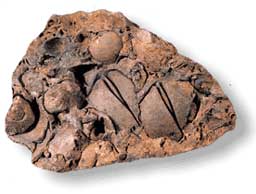Brachiopods

Brachiopods have a very long history of life on Earth (at least 550 million years). They first appear as fossils in rocks of earliest Cambrian age, and their descendants survive, albeit relatively rarely, in today's oceans and seas. They were particularly abundant during the Palaeozoic Era (248 to 545 million years ago), and are often the most common fossils in rock of that age.
Brachiopods are marine animals belonging to their own phylum, Brachiopoda, of the animal kingdom. Modern brachiopods occupy a variety of sea-bed habitats ranging from the Tropics to the cold waters of the Arctic and, especially, Antarctic.
Brachiopods are virtually defenceless and their shell, enclosing the animal's organs, is their only protection. Most are permanently attached by a fleshy stalk (the pedicle) to a hard, sea-floor surface, such as a rock outcrop, boulder or some other shell, and are incapable of actively pursuing food.
A few species can attach themselves directly to soft sediment and others remain unattached. The pedicle is the only soft tissue that protrudes outside the shell which opens and closes to allow food-bearing currents of water to pass through it.
Wide-hinged spiriferid brachiopods (below left) have been likened to birds. For example, in China, the common name of such forms translates as 'stone swallows'. There they are boiled in water with various herbs to produce medicinal potions and powders.


Unusually preserved Pentamerus oblongus have led to the rock in which they occur being called 'Government Rock' (above right). The original shell material of the brachiopods has dissolved away leaving arrow-like slits like the symbol used for Government bench-marks and on prison uniforms.


